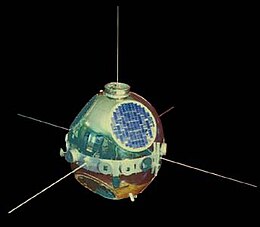SOLRAD 8
 | |
| Mission type | Solar science |
|---|---|
| Operator | NASA |
| COSPAR ID | 1965-093A |
| SATCAT no. | 1738 |
| Mission duration | Unknown |
| Spacecraft properties | |
| Manufacturer | Naval Research Lab |
| Launch mass | 56.7 kilograms (125 lb) |
| Start of mission | |
| Launch date | November 19, 1965, 22:11:30 UTC [1] |
| Rocket | Scout X-4 |
| Launch site | Wallops LA-3 |
| End of mission | |
| Last contact | August 1967 |
| Decay date | Unknown |
| Orbital parameters | |
| Reference system | Geocentric |
| Regime | Circular orbit |
| Eccentricity | 0.01302 |
| Perigee altitude | 704 kilometers (437 mi) |
| Apogee altitude | 891 kilometers (554 mi) |
| Inclination | 59.7 degrees |
| Period | 100.8 minutes |
| Epoch | 19 November 1965, 04:48:00 UTC |
The SOLRAD 8 satellite was one of the SOLRAD (Solar Radiation) program that began in 1960 to provide continuous coverage of solar radiation with a set of standard photometers. SOLRAD 8 was a spin-stabilized satellite oriented with its spin axis perpendicular to the sun-satellite line so that the 14 solar X-ray[2] and ultraviolet photometers[3] pointing radially outward from its equatorial belt viewed the sun on each revolution. Data were transmitted in real time by means of an FM/AM the satellite's telemetry system and were recorded by the stations on the STADAN tracking network.
The satellite observed the solar eclipse on May 20, 1966.[4] This observation may have been the first observation of a solar eclipse by an artificial satellite.[4]
The satellite performed normally, except for the spin system,[5] which failed to maintain 60 rpm (at spin rates below 10 rpm data reduction became difficult). The spin rate gradually decreased to 4 rpm on September 12, 1966.[6] At that time, ground command succeeded in reactivating spinup to 78 rpm, which exhausted the gas supply. From this point, the spin rate gradually decreased to 10 rpm in August 1967, when data collection was substantially decreased.[7]
See also
References
![]() This article incorporates public domain material from websites or documents of the National Aeronautics and Space Administration.
This article incorporates public domain material from websites or documents of the National Aeronautics and Space Administration.
- ^ "Solar-observing satellites". Rammb.cira.colostate.edu. Retrieved 2014-05-27.
- ^ ftp://ftp.ngdc.noaa.gov/STP/SOLAR_DATA/SATELLITE_ENVIRONMENT/XRAY_BGND/docs/solrad.txt
- ^ "Solrad". Designation-systems.net. Retrieved 2014-05-27.
- ^ a b Landini, M.; Russo, D.; Tagliaferri, G. L. (1966). "Solar Eclipse of May 20, 1966, observed by the Solrad 8 Satellite in X-ray and Ultra-violet Bands". Nature. 211 (5047): 393. Bibcode:1966Natur.211..393L. doi:10.1038/211393a0.
- ^ "SOLRAD 8". Space Archaeology. Retrieved 2014-05-27.
- ^ National Research Council (U.S.). Space Science Board, COSPAR (1967). United States Space Science Program: Report to COSPAR. National Academies. p. 47.
- ^ "NASA:SP-4312 Dreams, Hopes, Realities-Chapter 1:Goddard's First Forty: The Quest to Learn". History.nasa.gov. 1957-10-04. Retrieved 2014-05-27.
External links

